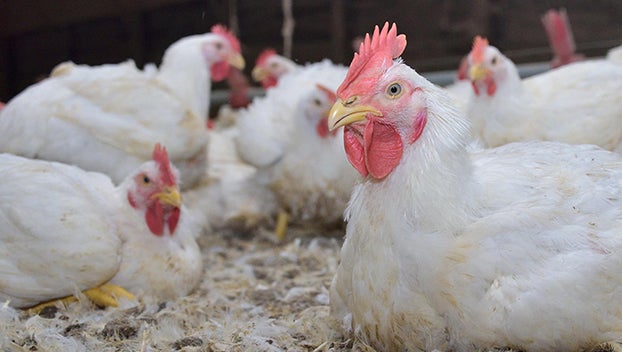Defend the flock, preventing avian influenza in Mississippi
Published 11:34 am Saturday, September 30, 2023

- Mississippi's Poultry was a $3.1 billion industry in 2023. (Photo by MSU Extension Service/Kevin Hudson)
By MSU Extension Service
Migratory birds are starting to make their way south to warmer climates and with the movement comes the risk of Highly Pathogenic Avian Influenza spreading. Mississippi has not had a positive HPAI detection in commercial poultry since March but a wild bird was positive in late August.
It took until November of last year for the disease to be detected in a poultry flock in Lawrence County several months after positive detections in wild birds. It is important to learn about avian influenza to help defend the flocks of birds.
Many strains of avian influenza (AI) virus exist worldwide that are capable of causing varying degrees of clinical illness in poultry. Wild birds that tend to favor aquatic environments, especially waterfowl and shorebirds, appear to be natural hosts for AI viruses, although domesticated poultry and other birds can also be affected.
Most AI viruses cause only mild disease in poultry. These are classified as low pathogenic avian influenza (LPAI) viruses. Pathogenicity is the ability of a virus to cause disease. However, some are classified as highly pathogenic avian influenza (HPAI) viruses, and these are much more potent than the LPAI varieties.
HPAI is an extremely infectious and fatal form of the disease that typically kills 95 to 100 percent of an infected flock. Once established, it can spread rapidly, with the potential to devastate the poultry industry by wiping out entire flocks of birds and leading to severe international trade restrictions.
In contrast, LPAI usually causes only minor illness in poultry flocks and may show no clinical signs of disease within the flock. However, in the field, some LPAI virus strains may mutate into HPAI viruses.
What Causes Avian Influenza?
Avian influenza is the result of infection from what are commonly called type A influenza viruses. Influenza A viruses have many different subtypes based on two types of proteins that project from the surface of the virus. These proteins are called hemagglutinin (H) and neuraminidase (N). There are multiple forms of both the hemagglutinin and neuraminidase protein; at least 18 hemagglutinins (H1 to H18) and 11 neuraminidases (N1 to N11) have been found in viruses from birds. The proteins are designated by numbers such as H2, H5, N2, N8, etc. The virus that caused so much concern for the poultry industry in 2014 and 2015 had a type 5 H and type 2 N signature and, therefore, is classified as the subtype H5N2. HPAI viruses usually contain the H5 or H7 hemagglutinin.
If an LPAI virus from wild birds is transferred to domestic poultry, it may take one of several different avenues. It may circulate inefficiently within the host and die out; it may become adapted to the new host and continue to circulate as an LPAI virus that shows little or no symptoms or mortality; or, if it is an H5 or H7 virus type (these have the capability to change from low pathogenic to high pathogenic), it may mutate into an HPAI virus capable of causing extreme mortality rates.
Transmission
Avian influenza viruses are shed in the feces and respiratory secretions of birds. In waterfowl, feces contains large amounts of the virus, and the dominant transmission route is thought to be fecal-oral. The respiratory route does not appear to play as critical a role as the fecal-oral route in transmission in waterfowl. However, once AI has entered a poultry flock, it can spread rapidly on the farm by both the fecal-oral route and the respiratory route, due to the close proximity of the birds. Fomites (clothes, shoes, shared equipment, and so forth) are also important factors in disease transmission. Wind-borne transmission between farms in close proximity cannot be ruled out but is not as likely a transmission route as other methods.
Realize there is a difference between transmission and spread of avian influenza. Transmission refers to the passing of the disease from one animal to another. Spread refers to the wide diffusion (in this case, geographically) of the disease among large numbers of animals. Most outbreaks of AI have been linked to movements of poultry and the unintended/accidental transfer of infected material such as poultry manure/litter or soil on vehicles, equipment, egg flats/cages, clothes, or shoes. Throughout the world, the unregulated movement of poultry is the most important way that the virus is spread.
Symptoms
The incubation period for AI in poultry varies depending on the virus dose present, species affected, exposure route, and several other factors. LPAI viruses usually cause only mild illness in poultry, but symptoms exhibited by individual birds may vary and do depend on the pathogenicity of the virus. Possible symptoms include appetite loss, dehydration, decreased egg production, misshapen eggs, decreased fertility or hatchability, depression, huddling, diarrhea, lethargy, and respiratory signs such as sneezing, coughing, watery eyes, nasal discharge, and swollen sinuses.
HPAI viruses usually cause severe illness in chickens and turkeys, with few birds within an infected flock surviving. Symptoms that may be observed before death include bloody nasal discharge, facial swelling, hemorrhaging under the skin and on the shanks, blue facial discoloration, and tracheal inflammation. There is no practical treatment for birds infected with HPAI.
What to Do
If you suspect something is wrong with your flock, say something immediately. If you are a commercial producer, contact your service tech for guidance and assistance at the first sign of a problem. If you are a backyard producer, contact
- your local county Extension agent;
- a veterinarian;
- the MSU Poultry Science Department (662-325-3416); ask for a poultry Extension specialist; or
- the Mississippi Board of Animal Health (601-359-1170 or the animal disaster hotline at 1-888-722-3106).
Keep in mind that normal, everyday mortality is not a major concern and does not require reporting. Doing so will only hinder efforts in determining the current status of the state’s poultry flocks. Therefore, do not overreact if you lose a bird every now and then. Normal mortality is common and will not be the result of AI. However, be aware that any unexplained sudden or drastic increase in mortality rate should be reported to officials. Whether you are a commercial producer or a backyard enthusiast, maintain and perhaps even increase a sound biosecurity program, prevent contact between your birds and wild birds (particularly waterfowl), and immediately report sick or dying birds to the proper officials.





